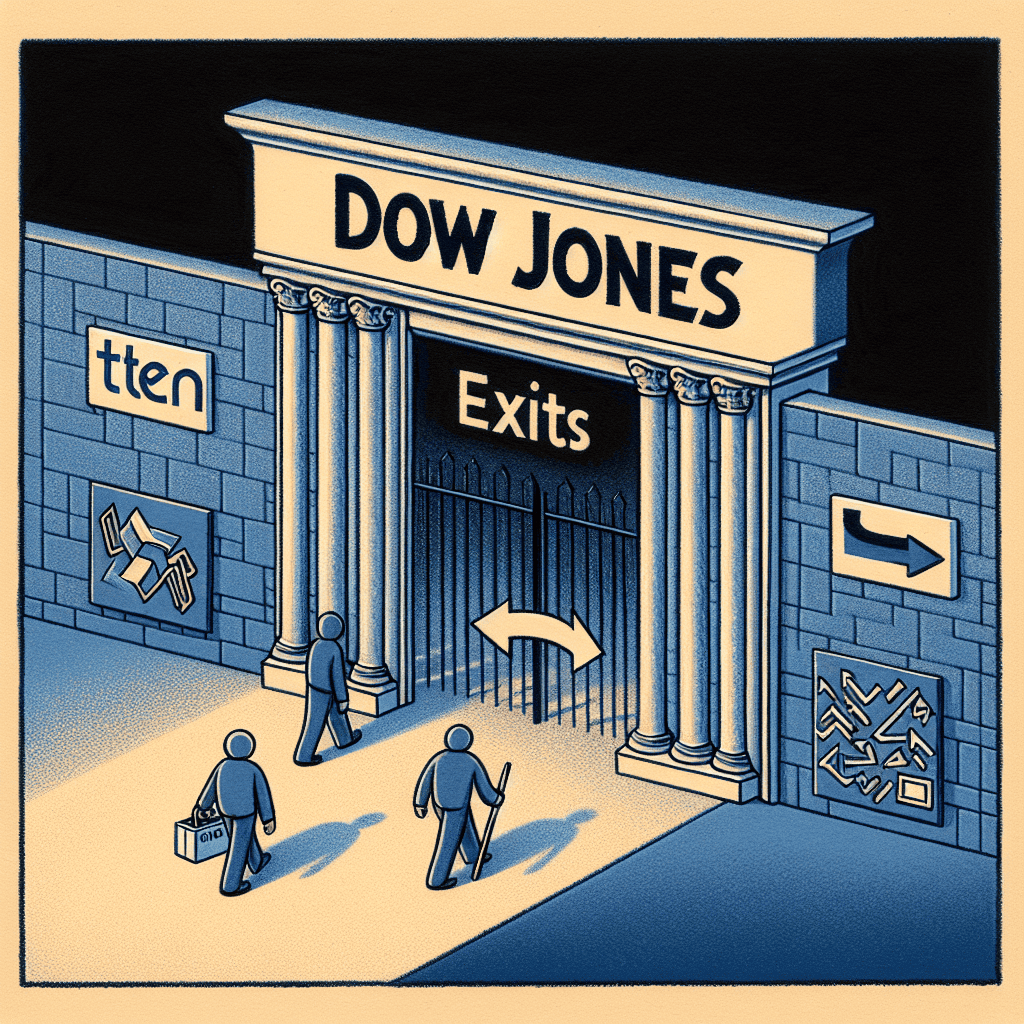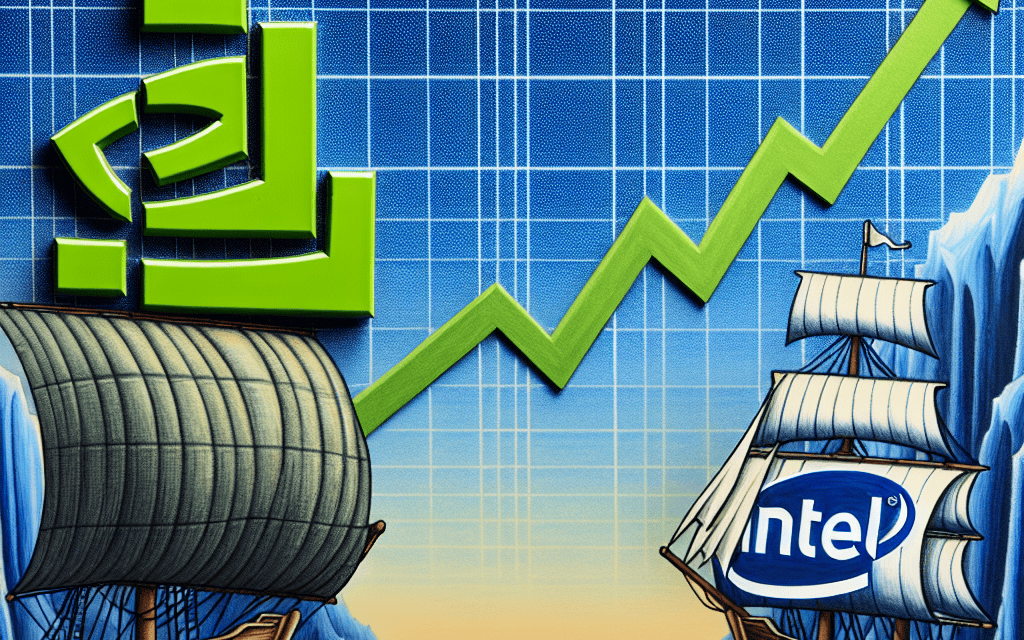“Power Shift: Nvidia Enters, Intel Exits – Redefining the Dow Jones Landscape”
Introduction
In a significant reshuffle of the Dow Jones Industrial Average, Nvidia Corporation has been added to the prestigious index, marking a notable shift in the technology landscape. This change comes as Intel Corporation, a long-standing member of the Dow, exits the index, reflecting the evolving dynamics and priorities within the tech industry. Nvidia’s inclusion underscores its growing influence and leadership in areas such as graphics processing, artificial intelligence, and data center technologies, while Intel’s removal highlights the challenges it faces in adapting to the rapidly changing market demands. This transition not only signifies a pivotal moment for both companies but also illustrates the broader trends shaping the future of technology and innovation.
Impact Of Nvidia’s Inclusion In The Dow Jones On The Stock Market
Nvidia’s recent inclusion in the Dow Jones Industrial Average marks a significant shift in the landscape of the stock market, reflecting broader trends in the technology sector and the evolving priorities of investors. This change, which sees Nvidia replacing Intel, underscores the growing importance of companies that are at the forefront of innovation in artificial intelligence and graphics processing. As Nvidia steps into this prestigious index, it not only highlights the company’s impressive growth trajectory but also signals a shift in the market’s focus towards cutting-edge technology.
The Dow Jones Industrial Average, a benchmark for the U.S. stock market, is often seen as a barometer of the American economy. Its composition is periodically adjusted to better reflect the changing economic landscape. Nvidia’s inclusion is a testament to its pivotal role in the tech industry, particularly in areas such as AI, gaming, and data centers. This move is likely to attract increased attention from investors who track the index, potentially boosting Nvidia’s stock price and market capitalization. Moreover, being part of the Dow Jones can enhance a company’s visibility and credibility, further solidifying its position as a leader in the tech sector.
Conversely, Intel’s removal from the index marks the end of an era. Once a dominant force in the semiconductor industry, Intel has faced increasing competition and challenges in recent years. Its exclusion from the Dow Jones may prompt a reevaluation of its strategies and priorities as it seeks to regain its footing in a rapidly evolving market. This transition highlights the dynamic nature of the tech industry, where innovation and adaptability are crucial for sustained success.
The impact of Nvidia’s inclusion extends beyond the company itself, influencing investor sentiment and market dynamics. As Nvidia joins the ranks of the Dow Jones, it brings with it a focus on sectors that are poised for significant growth. The company’s expertise in AI and machine learning is particularly relevant as these technologies become increasingly integrated into various industries. Investors may view Nvidia’s presence in the index as an endorsement of the potential of these technologies, leading to increased interest and investment in related sectors.
Furthermore, Nvidia’s inclusion may prompt other companies to accelerate their innovation efforts to remain competitive. As the tech landscape continues to evolve, companies that can effectively harness emerging technologies are likely to capture the attention of investors and stakeholders. This shift in focus towards innovation-driven growth could have a ripple effect across the stock market, encouraging a broader emphasis on research and development.
In addition to influencing investor behavior, Nvidia’s entry into the Dow Jones may also impact the index’s performance. Given Nvidia’s strong financial performance and growth prospects, its presence could contribute positively to the overall performance of the Dow Jones. This, in turn, may attract more investors to the index, further amplifying its influence on the stock market.
In conclusion, Nvidia’s inclusion in the Dow Jones Industrial Average represents a significant milestone for the company and the tech industry as a whole. It reflects the growing importance of innovation and technology in shaping the future of the economy. As Nvidia takes its place among the leading companies in the index, it not only highlights its own achievements but also sets the stage for a new era of growth and transformation in the stock market. This development underscores the dynamic nature of the market and the critical role that technology will continue to play in driving economic progress.
Historical Overview: Intel’s Journey In The Dow Jones Index
In a significant reshuffle of the Dow Jones Industrial Average, Nvidia has taken the place of Intel, marking a pivotal moment in the history of the index. This change reflects broader shifts in the technology sector and highlights the evolving landscape of the semiconductor industry. To understand the implications of this transition, it is essential to delve into Intel’s historical journey within the Dow Jones Index, a journey that has been marked by innovation, challenges, and transformation.
Intel’s inclusion in the Dow Jones Industrial Average in 1999 was a testament to its status as a leading force in the technology sector. At the time, Intel was at the forefront of the personal computer revolution, providing the microprocessors that powered a vast majority of PCs worldwide. Its dominance in the semiconductor industry was undisputed, and its financial performance was robust, making it a fitting addition to the prestigious index. Over the years, Intel’s presence in the Dow Jones symbolized the growing importance of technology companies in the global economy.
Throughout the early 2000s, Intel continued to innovate, introducing new generations of processors that pushed the boundaries of computing power. The company’s commitment to research and development allowed it to maintain a competitive edge, even as new players entered the market. However, the landscape of the semiconductor industry began to shift dramatically with the rise of mobile computing and the increasing demand for energy-efficient processors. Intel faced challenges in adapting to these changes, as competitors like ARM and Qualcomm gained traction in the mobile space.
As the 2010s progressed, Intel’s dominance was further tested by the emergence of new technologies such as artificial intelligence and cloud computing. Companies like Nvidia, with their focus on graphics processing units (GPUs), began to capture significant market share by catering to these burgeoning sectors. Nvidia’s GPUs became essential for AI research and data centers, positioning the company as a leader in the next wave of technological advancement. Meanwhile, Intel struggled to diversify its product offerings and keep pace with the rapid evolution of the industry.
The decision to replace Intel with Nvidia in the Dow Jones Industrial Average reflects these broader industry trends. Nvidia’s rise to prominence underscores the growing importance of AI and data-driven technologies, which are reshaping the global economy. This transition also highlights the challenges faced by established companies like Intel in adapting to new market dynamics. While Intel remains a major player in the semiconductor industry, its exclusion from the Dow Jones serves as a reminder of the need for continuous innovation and strategic adaptation.
In conclusion, Intel’s journey in the Dow Jones Index is a microcosm of the broader changes that have occurred in the technology sector over the past few decades. From its initial inclusion as a symbol of technological prowess to its recent replacement by Nvidia, Intel’s experience reflects the dynamic nature of the industry. As Nvidia takes its place in the index, it represents not only a shift in market leadership but also a new era of technological innovation. This transition serves as a poignant reminder of the ever-evolving landscape of the semiconductor industry and the relentless pace of change that defines the modern economy.
Nvidia’s Growth Trajectory Leading To Dow Jones Inclusion
Nvidia’s recent inclusion in the Dow Jones Industrial Average marks a significant milestone in the company’s growth trajectory, underscoring its rising influence in the technology sector. This development comes as Intel, a long-standing member of the index, exits, highlighting a shift in the technological landscape and investor sentiment. Nvidia’s ascent to the Dow Jones is not merely a reflection of its financial performance but also an acknowledgment of its strategic positioning in emerging markets such as artificial intelligence, gaming, and data centers.
Over the past decade, Nvidia has transformed from a niche graphics processing unit (GPU) manufacturer into a powerhouse driving innovation across multiple industries. The company’s GPUs have become essential components in the development of AI technologies, enabling advancements in machine learning and deep learning. This has positioned Nvidia at the forefront of the AI revolution, a sector that is expected to see exponential growth in the coming years. As businesses and governments increasingly adopt AI solutions, Nvidia’s role as a key enabler of these technologies has solidified its reputation as a leader in the tech industry.
Moreover, Nvidia’s strategic acquisitions have played a crucial role in its growth. The acquisition of Mellanox Technologies in 2020, for instance, expanded Nvidia’s capabilities in high-performance computing and networking, further enhancing its data center offerings. This move not only diversified Nvidia’s portfolio but also strengthened its competitive edge against rivals. Additionally, Nvidia’s proposed acquisition of Arm Holdings, although facing regulatory hurdles, underscores its ambition to dominate the semiconductor industry by integrating Arm’s CPU capabilities with its own GPU expertise.
In contrast, Intel’s exit from the Dow Jones reflects the challenges it has faced in recent years. Once a dominant force in the semiconductor industry, Intel has struggled with production delays and increased competition from companies like AMD and Nvidia. These challenges have impacted its market share and investor confidence, leading to its removal from the prestigious index. Intel’s departure serves as a reminder of the rapidly changing dynamics within the tech sector, where innovation and adaptability are crucial for sustained success.
Nvidia’s inclusion in the Dow Jones is also indicative of broader market trends. Investors are increasingly favoring companies that are not only financially robust but also positioned to capitalize on future technological advancements. Nvidia’s focus on AI, gaming, and data centers aligns with these trends, making it an attractive option for investors seeking growth opportunities in the tech sector. Furthermore, Nvidia’s commitment to sustainability and ethical practices has resonated with socially conscious investors, adding another layer of appeal to its stock.
As Nvidia continues to innovate and expand its reach, its presence in the Dow Jones is likely to bolster its visibility and attract further investment. The company’s ability to navigate the complexities of the tech industry and adapt to emerging trends will be crucial in maintaining its upward trajectory. While challenges remain, particularly in terms of regulatory scrutiny and competition, Nvidia’s strategic vision and execution have positioned it well for future success.
In conclusion, Nvidia’s inclusion in the Dow Jones Industrial Average is a testament to its remarkable growth and strategic foresight. As Intel exits the index, Nvidia’s rise highlights the shifting dynamics within the tech industry and the importance of innovation in driving long-term success. As the company continues to push the boundaries of technology, its role in shaping the future of the industry is set to expand, offering exciting possibilities for investors and consumers alike.
Implications For The Tech Industry With Nvidia In The Dow Jones

The recent inclusion of Nvidia in the Dow Jones Industrial Average, replacing Intel, marks a significant shift in the landscape of the technology sector. This change not only reflects the evolving dynamics within the industry but also signals broader implications for investors and companies alike. As Nvidia takes its place among the 30 prominent companies that comprise this prestigious index, it is essential to understand the underlying factors that led to this transition and what it means for the tech industry as a whole.
Nvidia’s rise to prominence can be attributed to its strategic focus on graphics processing units (GPUs) and its successful expansion into artificial intelligence (AI) and data center markets. Over the past decade, the company has consistently demonstrated its ability to innovate and adapt to the changing demands of technology. This adaptability has allowed Nvidia to capitalize on the growing need for high-performance computing, particularly in areas such as machine learning, autonomous vehicles, and cloud computing. Consequently, Nvidia’s financial performance has been robust, with significant revenue growth and a strong market capitalization, making it an attractive candidate for inclusion in the Dow Jones.
In contrast, Intel’s removal from the index highlights the challenges faced by traditional semiconductor companies in keeping pace with rapid technological advancements. While Intel has been a dominant player in the microprocessor market for decades, it has struggled to maintain its competitive edge in recent years. Delays in product launches and increased competition from companies like AMD and Nvidia have eroded Intel’s market share and investor confidence. This shift underscores the importance of agility and innovation in the tech industry, where companies must continuously evolve to remain relevant.
The inclusion of Nvidia in the Dow Jones is likely to have several implications for the tech industry. Firstly, it underscores the growing importance of AI and data-driven technologies, which are becoming integral to various sectors, including healthcare, finance, and entertainment. As Nvidia continues to develop cutting-edge solutions in these areas, its influence on the industry is expected to expand, driving further investment and innovation.
Moreover, Nvidia’s presence in the Dow Jones may encourage other tech companies to prioritize research and development in AI and related fields. This could lead to increased collaboration and partnerships, fostering a more dynamic and interconnected tech ecosystem. As companies strive to emulate Nvidia’s success, the industry may witness a surge in new technologies and applications that could transform how businesses operate and interact with consumers.
Additionally, Nvidia’s inclusion in the index may have implications for investors, as it reflects a shift in the types of companies that are deemed representative of the broader economy. With Nvidia’s focus on future-oriented technologies, its presence in the Dow Jones may attract a new wave of investors interested in tech-driven growth opportunities. This could lead to increased volatility in the index, as the performance of tech stocks is often influenced by rapid changes in market conditions and investor sentiment.
In conclusion, Nvidia’s entry into the Dow Jones Industrial Average, replacing Intel, signifies a pivotal moment for the tech industry. It highlights the growing importance of AI and data-driven technologies, while also emphasizing the need for companies to remain agile and innovative. As Nvidia continues to shape the future of technology, its influence on the industry and the broader economy is likely to be profound, paving the way for new opportunities and challenges in the years to come.
Comparative Analysis: Nvidia Vs. Intel In The Stock Market
Nvidia’s recent inclusion in the Dow Jones Industrial Average marks a significant shift in the landscape of the stock market, particularly in the technology sector. This change comes as Intel, a long-standing member of the index, exits, highlighting a broader transformation within the industry. The Dow Jones, a prestigious index that tracks 30 prominent companies listed on stock exchanges in the United States, serves as a barometer for the overall health of the economy. Nvidia’s entry into this exclusive club underscores its growing influence and the evolving dynamics of the tech market.
Nvidia, known for its cutting-edge graphics processing units (GPUs) and advancements in artificial intelligence (AI), has seen a meteoric rise in its stock value over recent years. This growth is largely attributed to the increasing demand for high-performance computing, driven by sectors such as gaming, data centers, and AI research. As these industries continue to expand, Nvidia’s innovative products have positioned it as a leader in providing the necessary hardware to support this growth. Consequently, investors have shown immense confidence in Nvidia’s potential, propelling its market capitalization to new heights.
In contrast, Intel, once a dominant force in the semiconductor industry, has faced challenges in maintaining its competitive edge. The company has struggled with delays in its manufacturing processes and has been slow to adapt to the rapid changes in technology demands. As a result, Intel’s stock performance has lagged behind its peers, leading to its removal from the Dow Jones index. This shift reflects a broader trend in the tech industry, where companies that fail to innovate and adapt quickly find themselves at a disadvantage.
The transition from Intel to Nvidia in the Dow Jones is not merely a change of names but a reflection of the shifting priorities within the technology sector. While Intel has traditionally focused on central processing units (CPUs) for personal computers and servers, Nvidia’s emphasis on GPUs and AI solutions aligns more closely with the current technological trends. The rise of AI and machine learning has created a demand for specialized hardware that can handle complex computations efficiently, a niche that Nvidia has successfully capitalized on.
Moreover, Nvidia’s strategic acquisitions and partnerships have further solidified its position in the market. By acquiring companies that complement its core business, Nvidia has expanded its capabilities and entered new markets, such as autonomous vehicles and cloud computing. These strategic moves have not only diversified Nvidia’s revenue streams but also enhanced its reputation as a forward-thinking company poised for future growth.
In summary, the inclusion of Nvidia in the Dow Jones Industrial Average, coupled with Intel’s exit, signifies a pivotal moment in the stock market and the technology industry. Nvidia’s rise reflects the increasing importance of AI and high-performance computing, while Intel’s challenges highlight the need for continuous innovation and adaptation. As the tech landscape continues to evolve, companies that can anticipate and respond to emerging trends will likely shape the future of the industry. This transition serves as a reminder of the dynamic nature of the stock market and the ever-changing forces that drive it.
Investor Reactions To Nvidia’s Entry And Intel’s Exit From The Dow Jones
The recent reshuffling of the Dow Jones Industrial Average, one of the most closely watched stock indices in the world, has sparked significant interest and discussion among investors. Nvidia, a leading player in the semiconductor industry, has been added to the index, replacing Intel, a long-standing member. This change marks a significant shift in the landscape of the technology sector and has elicited varied reactions from investors and market analysts alike.
Nvidia’s inclusion in the Dow Jones is seen by many as a reflection of its growing influence and success in the technology sector. Over the past few years, Nvidia has experienced substantial growth, driven by its advancements in graphics processing units (GPUs) and its strategic expansion into areas such as artificial intelligence and data centers. This growth trajectory has not only increased Nvidia’s market capitalization but has also positioned it as a key player in the future of technology. Consequently, its entry into the Dow Jones is perceived as a validation of its business model and strategic direction.
On the other hand, Intel’s removal from the index has raised questions about its current standing in the industry. Once a dominant force in the semiconductor market, Intel has faced challenges in recent years, including increased competition and delays in product development. These issues have impacted its market performance and, ultimately, its position in the Dow Jones. For some investors, Intel’s exit is a signal to reassess their portfolios and consider the shifting dynamics within the technology sector.
The reactions from investors to these changes have been mixed. Some view Nvidia’s entry as an opportunity to capitalize on its upward momentum. They believe that Nvidia’s innovative approach and strong market position will continue to drive its growth, making it an attractive investment option. Moreover, Nvidia’s presence in the Dow Jones is expected to increase its visibility among institutional investors, potentially leading to further appreciation in its stock price.
Conversely, Intel’s removal has prompted a more cautious response from certain investors. While some see it as a temporary setback, others are concerned about the long-term implications for the company. Intel’s management has acknowledged the challenges it faces and has outlined plans to regain its competitive edge. However, the effectiveness of these strategies remains to be seen, and investors are closely monitoring the company’s progress.
In addition to individual investor reactions, the broader market implications of this change are also noteworthy. The Dow Jones Industrial Average is often viewed as a barometer of the U.S. economy, and changes to its composition can influence market sentiment. Nvidia’s inclusion is likely to attract attention to the technology sector, highlighting its growing importance in the modern economy. This shift may encourage investors to allocate more resources to technology stocks, potentially driving further growth in the sector.
In conclusion, Nvidia’s entry into the Dow Jones and Intel’s exit have generated significant interest and debate among investors. While Nvidia’s inclusion is seen as a testament to its success and potential, Intel’s removal raises questions about its future prospects. As the technology sector continues to evolve, these changes underscore the importance of adaptability and innovation in maintaining a competitive edge. Investors will undoubtedly keep a close eye on both companies as they navigate this new landscape, seeking opportunities to optimize their investment strategies in response to these developments.
Future Prospects For Nvidia As A Dow Jones Component
Nvidia’s recent inclusion in the Dow Jones Industrial Average marks a significant milestone for the company, reflecting its growing influence and importance in the technology sector. As Intel exits the index, Nvidia’s entry symbolizes a shift in the technological landscape, highlighting the increasing relevance of graphics processing units (GPUs) and artificial intelligence (AI) in modern computing. This transition not only underscores Nvidia’s robust market position but also sets the stage for its future prospects as a key player in the Dow Jones.
Nvidia’s rise to prominence can be attributed to its strategic focus on innovation and its ability to adapt to the evolving demands of the tech industry. The company’s GPUs have become essential components in various applications, ranging from gaming and data centers to AI and machine learning. This versatility has allowed Nvidia to capture a significant share of the market, positioning it as a leader in the semiconductor industry. As a Dow Jones component, Nvidia is now poised to leverage its technological advancements to further solidify its standing and drive future growth.
Moreover, Nvidia’s inclusion in the Dow Jones comes at a time when the demand for AI and machine learning technologies is surging. The company’s GPUs are integral to these technologies, providing the computational power necessary to process vast amounts of data efficiently. This capability is crucial as industries across the board increasingly rely on AI to enhance productivity, optimize operations, and drive innovation. Consequently, Nvidia’s role in facilitating these advancements positions it as a critical enabler of the digital transformation sweeping through various sectors.
In addition to its technological prowess, Nvidia’s financial performance has been impressive, with consistent revenue growth and strong profitability. The company’s ability to generate substantial cash flow has enabled it to invest in research and development, ensuring a continuous pipeline of cutting-edge products. This financial strength not only supports Nvidia’s ongoing innovation but also enhances its appeal to investors, who view the company as a stable and promising investment opportunity. As a member of the Dow Jones, Nvidia’s financial health will be under even greater scrutiny, but its track record suggests it is well-equipped to meet these expectations.
Furthermore, Nvidia’s strategic acquisitions and partnerships have played a pivotal role in its ascent. The company’s acquisition of Mellanox Technologies, for instance, expanded its capabilities in high-performance computing and networking, complementing its existing product portfolio. Such strategic moves have allowed Nvidia to diversify its offerings and tap into new markets, thereby broadening its revenue streams. As Nvidia continues to explore opportunities for growth, its ability to identify and capitalize on strategic partnerships will be crucial in maintaining its competitive edge.
Looking ahead, Nvidia’s future prospects as a Dow Jones component appear promising. The company’s commitment to innovation, coupled with its strong financial foundation and strategic vision, positions it well to navigate the challenges and opportunities that lie ahead. As the demand for advanced computing solutions continues to rise, Nvidia’s role in shaping the future of technology is likely to expand, further cementing its status as a leader in the industry. In conclusion, Nvidia’s inclusion in the Dow Jones not only reflects its past achievements but also heralds a new chapter in its journey, one that promises continued growth and influence in the ever-evolving tech landscape.
Q&A
1. **What is the Dow Jones Industrial Average?**
The Dow Jones Industrial Average (DJIA) is a stock market index that measures the stock performance of 30 prominent companies listed on stock exchanges in the United States.
2. **When did Nvidia join the Dow Jones Industrial Average?**
Nvidia joined the Dow Jones Industrial Average on August 31, 2020.
3. **Why did Intel exit the Dow Jones Industrial Average?**
Intel exited the Dow Jones Industrial Average as part of a reshuffling to better reflect the American economy, particularly the growing importance of technology and software companies.
4. **What impact did Nvidia’s inclusion have on the Dow Jones?**
Nvidia’s inclusion in the Dow Jones brought a company with strong growth in the technology sector, particularly in areas like AI and gaming, which are increasingly important in the modern economy.
5. **How did Nvidia’s stock perform after joining the Dow Jones?**
Nvidia’s stock generally performed well after joining the Dow Jones, benefiting from its strong position in the tech industry and increased visibility from being part of the index.
6. **What other companies were affected by the Dow Jones reshuffle in 2020?**
Along with Intel’s exit, ExxonMobil and Pfizer were also removed from the Dow Jones, while Salesforce, Amgen, and Honeywell were added.
7. **What criteria are used to select companies for the Dow Jones Industrial Average?**
Companies are selected for the Dow Jones Industrial Average based on factors like their industry leadership, financial health, and representation of the broader economy, with a focus on maintaining a diverse and balanced index.
Conclusion
Nvidia’s inclusion in the Dow Jones Industrial Average, replacing Intel, marks a significant shift in the technology landscape and reflects the evolving priorities of the stock market index. This change underscores Nvidia’s growing influence and leadership in the semiconductor industry, driven by its advancements in graphics processing units (GPUs) and artificial intelligence (AI) technologies. Meanwhile, Intel’s removal highlights the challenges it faces in maintaining its competitive edge amid rapid technological advancements and shifting market dynamics. Overall, this transition in the Dow Jones index illustrates the dynamic nature of the tech sector and the importance of innovation and adaptability for companies to remain relevant and influential in the market.





